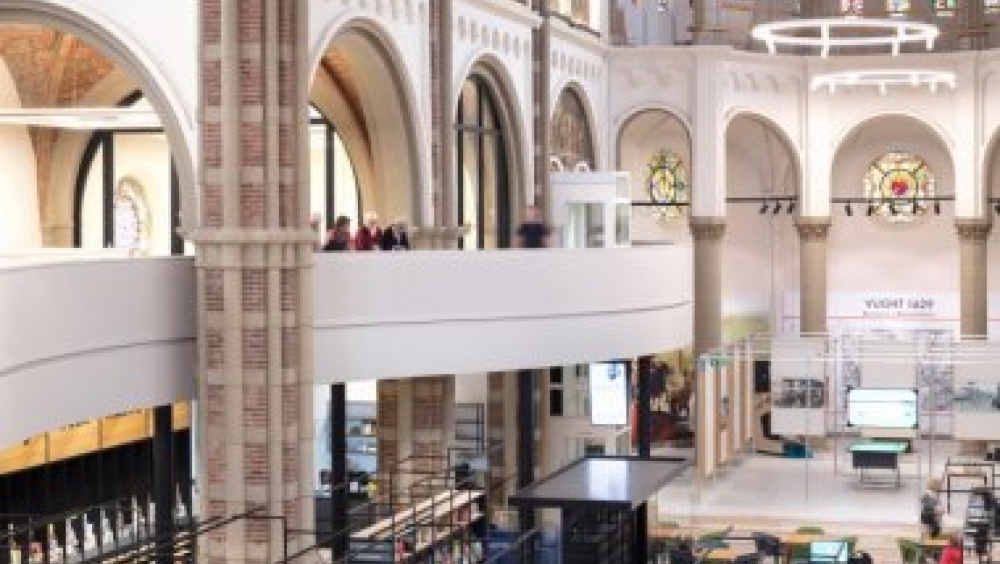From Saint Peter to Social Centre DePetrus in Vught
Saint Peter church was built in 1884 by Carl Weber. His design is now considered ‘an extremely important experiment’ of his, because at that time the mix of gothic and romanesque styles was very unusual. On April 7 2018 this national monument was opened again as ‘Social Centre DePetrus’. This centre houses several social organisations, a museum, a library and a third world shop. DePetrus is managed by a board that works for free. The daily activities are done by volunteers that we educate ourselves. There’s a coordinator, a PR woman and a caretaker that are paid.
From Saint Peter to Social Centre DePetrus in Vught Saint Peter church was built in 1884 by Carl Weber. His design is now considered ‘an extremely important experiment’ of his, because at that time the mix of gothic and romanesque styles was very unusual. And it has beautiful stained glass windows, mostly by Weber himself, and many paintings of Charles Grips. But in 2005 the church was closed for safety reasons because of chalk falling down. On April 7 2018 this monument was opened again as ‘Social Centre DePetrus’. This centre houses several social organisations, a museum, a library and a third world shop. DePetrus is managed by a board that works for free. The daily activities are done by volunteers that we educate ourselves. There’s a coordinator, a PR woman and a caretaker that are paid. A group of worried people saved the church from demolition. In 2005 the group started the Foundation for the Preservation of the Petrus’. They thought of different usages for the church. Mgr. Hurkmans, the bisshop of ’s-Hertogenbosch initially had his reservations. In ’s-Hertogenbosch a church had been turned into a party centre a few years before. He thought that that was very disrespectful. He preferred demolition to using eclesiastical buildings for such purposes. After their first negative contacts with the bisshop the foundation reconsidered their plans and eventually proposed a social destination, which the bisshop after a lot of deliberationcould agree with. ´A valuable pilot project from which the parishes with monumental churches could benefit in the future,´ he said. So, demolition was off. It took a lot of perseverance to overcome the obstacles that followed. In the first place there were financial obstacles. DePetrus had been given € 2,000,000.00 of subsidies by local, provincial and national governments, but that was not enough. Eventually seven Vught entrepeneurs were prepared to to pay the long lease of the church and to invest in the restauration and redesigning of the church. The redesigning cost € 2,300,000.00 and was mainly paid for by the revenues of the buildings that the residents used before they came to DePetrus. Secondly there was the issue of the residents of the church. More than once a possible resident pulled out, but in the end five organisations decided to join in, which made the development of DePetrus possible. The first reaction of visitors of DePetrus usually is how beautifully and respectfully old and new are interwoven in DePetrus. That’s in the first place of course due to the social character of the repurposing which is in line with the original function. Architecturally speaking you also see love and respect for the original function. All religious parts have been maintained with the exception of the altar, the pews, the stations of the cross and the organ. A slender mezzanine floor has been added which keeps the original function and architecture intact and even strengthens it with beautiful lines of sight. It offers a panoramic view of the church as a whole which is unique in the Netherlands. The Governmental Bureau for Cultural Heritage published an article about DePetrus, titled ‘The Recipe’ as an example for repurposing. DePetrus is open to the public every day and during the first year after the opening it received more than 200,000 visitors. From the very beginning a choice was made for synergy. The residents of DePetrus do not function each on their own island, but are physically interwoven in such a way that visitors of DePetrus come across all its functions. The different organizations programme as much as possible together. In that way, the billiards players of ABZ discover the reading table of the library, visitors of the library take part in the courses of ABZ, etc. DePetrus has thus become the ‘livingroom of Vught’. The number of members of all organizations has grown considerably and their targetgroups have become more mixed, for instance as far as age and social background are concerned. DePetrus is also used for public events like the arrival of Sinterklaas, Festival Vught Digital, Open Monument Day, exhibitions and chess tournaments. The interior is on rails that can be pushed aside so that the nave comes free to create a large space. Prior to the redesigning, € 2,400,000.00 were invested in the renovation of the church. The renovations concerned the roof, leadworks, gutter and drains, to prevent further leakage; electrical heating installations and radiators under the paintings and windows to prevent cold trap; stained glass windows have been taken out and restored; the floor has been removed and replaced by a floor system with isolation and heating. In the future we will keep on working on further sustainability. We are thinking about double window frames for the stained glass window and an airlock function at the entrance.
In the first place it's important because we, by preserving this monument, maintain cultural heritage. The aim of repurposing was to provide Vught with a facility that shows the strength of synergy. The international reclaim we received is an indication of how succesfully this has been done.
